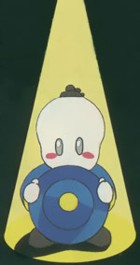|
Many fans of retro games back in the 80's might know of a game titled "Soko-Ban" (as well as Soukoban or Sokoban), which was originally created by a man named Hiroyuki Imabayashi and published by a software house known as THINKING RABBIT. Basically, Soko-Ban had you push boxes around small spaces in order to solve a puzzle to make it to the next level. Despite how simple the concept sounds, the game provided players with difficult puzzles and became so popular that many different versions of the games were produced worldwide across numerous different platforms. Anyone remember that game "Shove It! - The Warehouse Game" for the classic Sega Genesis? How about "Boxxle" or "Boxxle 2" which can be found on the popular Game Boy handheld? The aforementioned titles are but a small handful of titles related to Soko-Ban. You can even play Soko-Ban right now on the internet. Unsurprisingly, there are variants of Soko-Ban and games that take its core ideas to heart and Shikinjo just so happens to be one of those games.
There are numerous ports of Shikinjo that go under various names, but this port is published by Sunsoft, a company loved for publishing titles like Blaster Master and Aero the Acrobat. The game is developed by ScapTrust (also known as Scap Trust), who have an unusual history that is connected with THINKING RABBIT, Micro Cabin (known for games like Xak: The Art of Visual Stage, Mystaria: Realms of Lore, and many more), HummingBirdSoft, and other companies according to SIT's (Japanese) site. ScapTrust has made mostly simple titles, but they are also known for an old MSX-2 game known as "Gall Force - Eternal Story", which was an adult text-adventure game based off of an old and popular anime with the same name. In this Shikinjo port, you control a hopping Chinese vampire as he is traveling around the Forbidden City. As you might expect from looking at the box, your vampire pal won't be sucking any blood; He'll be you best friend as you play through the dozens of levels present throughout the game.
Shikinjo is interesting due to the style and design of the game. On the surface, the game has a similar premise to the classic Soko-Ban game. You must push tiles around a small room to reach the exit. However, you don't push around just any old tiles or wooden boxes...but you DO push around Mahjong tiles. In order to progress through Shikinjo, you must match together a pair of identical Mahjong tiles to make them disappear. In that sense, Shikinjo actually combines elements of Soko-Ban with elements of Mahjong Solitaire. However, there are good tiles and tiles that shouldn't be paired together. In Shikinjo, you will want to match tiles of the "circle" suit, the "bamboo" suit, and the "character" suit that is represented by Chinese characters. There are tiles from the Wind and Dragon tile sets too. If you push a tile against them, the tiles won't be eliminated...instead, they will transform into an unmovable block bearing the same symbol! This makes it harder to move around the area and much harder to make it to the exit of the level. There are also other tiles such as a tile with a picture of a piece of cake and another one with a candy cane on it that are unmovable and will impede your progress. You'll want to watch out for them and eliminate as much as possible.
While solving a puzzle in Shikinjo is a reward in and of itself, the real challenge behind the game is to solve the game using as few turns as possible. Each step...errr, I mean hop...that's right, HOP! Your character couldn't be a hopping Chinese vampire if he didn't hop! Anyhow, each hop you make is counted as a turn and at the top-left corner of the screen, you will notice two numbers. The number on the left is the current number of moves that you have made. The number on the right is the minimum number of movements needed to beat the level. If you exceed that number, then you are probably finishing the puzzle differently than the developers, though you can still finish the level. You can get rid of the movement counter altogether by pressing the start button. You can also bring up a window that has several commands. You can get help (which cancels one mistake you've made), give up (which takes a life), turn off the music, or end your game. You must play stages in sets of five and after every five stages, you are rewarded with little scenes that show your character doing various silly things and you are also given a five character password to resume play at your earliest convenience.
Shikinjo doesn't possess much aesthetic value visually. The colors are simple and the environments thrive on simplicity. Naturally, you must expect to encounter many rooms that look identical to each other, making the game seem redundant. Your character does his little hop as he moves around the rooms, but there isn't much else that animates. The game also hits you over the head with a very limited number of audio tracks. In Shikinjo's defense, what little music that is present is nicely done and quite catchy. However, you will hear the same limited selection of music throughout the entire game. Still, you have the option of turning it off if you've had enough. Soko-Ban didn't become popular because of visuals or sound; it became popular because it was able to feed hungry minds. Did Shikinjo feed my hungry mind? Indeed, it most certainly did. Not only did the game taunt me with perplexing puzzles that required me to use every ounce of my gray matter, the game was able to intrigue me more since it starred an unusual character placed in unusual environments. I know people who have enjoyed this title a great deal and if you look beyond the dated visuals and lack of variety in the music, you may actually enjoy this more than you've enjoyed Soko-Ban. For those who haven't played Soko-Ban, I would still recommend it to anyone looking for a challenge (otherwise, you'll probably pull your hair out!) and Shikinjo is nice to play in small doses in an area where you can think peacefully. It's a great puzzle game on the go, especially if you are fond of old-school logic puzzlers.- Written by Vyse the determined - |




 Year: 1991
Publisher: Sunsoft
Developer(s) and Others: Sunsoft, ScapTrust
# of Players: 1
# of Saves: None (Utilizes the password feature)
Estimated Market Value as of 03/09/2008:
* $?? - $?? (U.S. Dollars/USD, JPN ver.)
Fan Translated: No
Other Info: Also known as "Shikinjou" ,"Shikinjyo", "Shikinjoh", "Shikin Castle", and even "Shikinjo?". The name seems to differ based on whoever published the game as well as the platform the game was released on. Also, the names can be separated like Shi Kin Jo, Shi Kin Jyo...it's really quite confusing. The NES and Game Boy versions of the game are published by Toei Animation.
Quick Game Overview: Available HERE.
Year: 1991
Publisher: Sunsoft
Developer(s) and Others: Sunsoft, ScapTrust
# of Players: 1
# of Saves: None (Utilizes the password feature)
Estimated Market Value as of 03/09/2008:
* $?? - $?? (U.S. Dollars/USD, JPN ver.)
Fan Translated: No
Other Info: Also known as "Shikinjou" ,"Shikinjyo", "Shikinjoh", "Shikin Castle", and even "Shikinjo?". The name seems to differ based on whoever published the game as well as the platform the game was released on. Also, the names can be separated like Shi Kin Jo, Shi Kin Jyo...it's really quite confusing. The NES and Game Boy versions of the game are published by Toei Animation.
Quick Game Overview: Available HERE.





